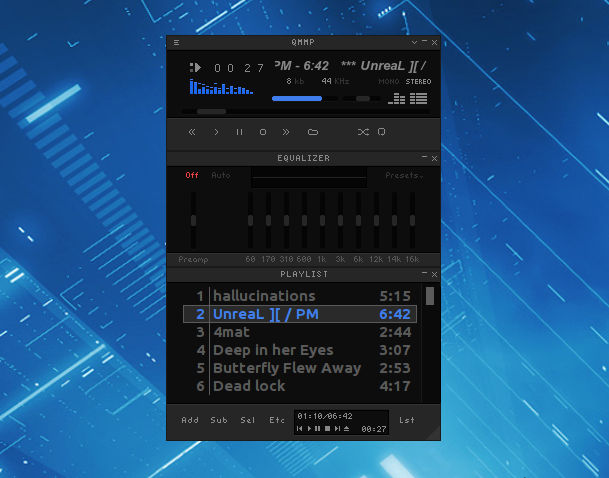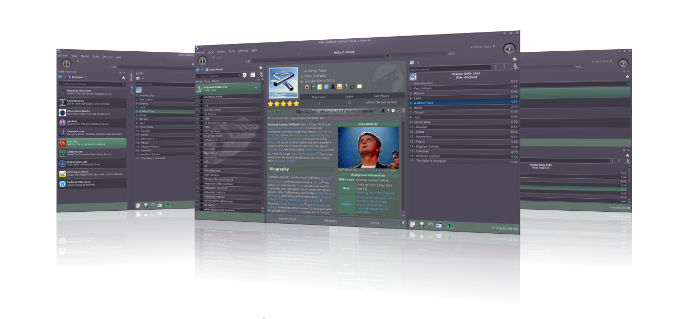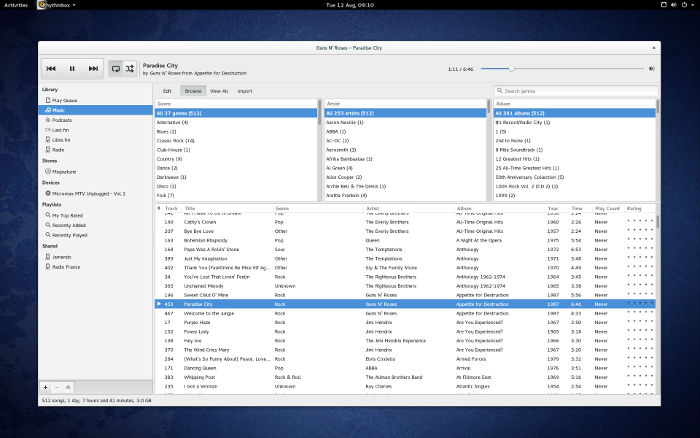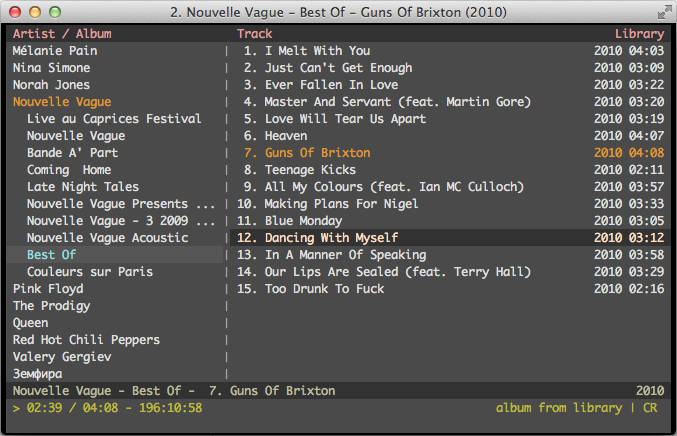Five Linux music players to give your ears the ultimate music experience
Are you tired of the music player on Windows or Mac? Do you want to find a music player on Linux that can meet all your needs? If your answer is yes, then you should definitely read this article. We recommend five of the best music players on Linux for you. They are not only powerful in function and beautiful in interface, but also compatible with a variety of audio formats and network services. Whether you want to listen to local music, listen to radio stations online or download lyrics and album art, these music players make it easy. Let’s take a look!
1、 Qmmp
Qmmp is not the most feature-rich (or the most stable) Linux music player, but it is one of my favorites, which is why I put it first. I know there are better players, but I just love this one and use it the most. It does crash, and there are a lot of files it can't play, but I still love it the most regardless. Pictured above!

Qmmp is WinAMP on Linux. It's (relatively) lightweight and has a decent feature set. Since I grew up with WinAMP and I love its keyboard shortcuts, it was a surprise to me to have a player like WinAMP on Linux. For audio formats, Qmmp can play most popular formats, such as MPEG1 layer 2/3, Ogg Vorbis and Opus, native FLAC/Ogg FLAC, Musepack, WavePack, audio track modules (mod, s3m, it, xm, etc.) , ADTS AAC, CD Audio, WMA, Monkey's Audio (and other formats provided by the FFmpeg library), Midi, SID and Chiptune formats (AY, GBS, GYM, HES, KSS, NSF, NSFE, SAP, SPC, VGM, VGZ and VTX).
2、Amarok
Amarok is KDE's music player, of course you can also use it in other desktop environments. It is one of the oldest music players on Linux.

Amarok can play a large number of audio formats, but its main advantage is its rich set of plug-ins. This software comes with extensive documentation, although it has not been updated recently. Amarok is also known for its integration with various web services such as Ampache, Jamendo Service, Last.fm, Librivox, MP3tunes, Magnatune, and the OPML podcast directory.
3、Rhythmbox
Since I just mentioned Amarok and the KDE music player, let's turn to Gnome's default music player, Rhythmbox. Since it comes with Gnome, you can guess that it is a popular software. It is not only a music player, but also a music management software. It supports MP3 and OGG, as well as a dozen other file formats, and also includes Internet radio, iPod service integration, audio file playback, audio CD burning and playback, music sharing, and podcasts. All in all, it's a decent player, but that doesn't mean you'll like it best. Try it out and see if you like it. If you don't like it, take a look below.

4、 VLC
Although VLC is best known as a video player, it is also a great music player just from the fact that it supports the most codecs. Files it can't play are unlikely to be able to be opened by other players. VLC is highly customizable and has many extensions. It can run on Windows, Linux, Mac OS X, Unix, iOS, Android and other platforms. 
What I personally don’t like about VLC is that it takes up too many resources. And I have used it to open some files, but the playback quality is far from top-notch. This software often closes for no reason when playing some files that are not difficult for other players to handle. But it probably has nothing to do with the player, it may be a problem with the file itself. Even though VLC is not among my regular programs, I still wholeheartedly recommend it.
5、 Cmus
If you love command line programs, then Cmus will be your cup of tea. You can use it to play Ogg Vorbis, MP3, FLAC, Opus, Musepack, WavPack, WAV, AAC, MP4, Audio CD and all formats supported by ffmpeg (WMA, APE, MKA, TTA, SHN, etc.) and libmodplug. You can also use it to play Shoutcast or Icecast audio streams. It's not the most feature-rich music player, but it has all the basic and advanced features. Its main advantage is that it is very lightweight and its memory requirements are really small.

All of these music players are great and have their strengths. I can't say which one is the best, it's more a matter of personal preference and needs. Most of these players are either installed as default options in the distribution or can be easily found in the package manager. Just open Synaptic, Software Center, or whichever package manager you use for your distribution, search for and install them. You can also use the command line, or just double-click the installation file downloaded from the website. Which method to use is up to you.
Wait, is this the end?
No, no, I know what you are going to say. As a Chinese Linux fan, you will definitely say that I have lost the most important one: NetEase Cloud Music. If I don’t mention it, you will definitely protest.
Yes, I strongly recommend "NetEase Cloud Music" and also like domestic manufacturers for supporting open source and Linux.

The above is the detailed content of Five Linux music players to give your ears the ultimate music experience. For more information, please follow other related articles on the PHP Chinese website!

Hot AI Tools

Undresser.AI Undress
AI-powered app for creating realistic nude photos

AI Clothes Remover
Online AI tool for removing clothes from photos.

Undress AI Tool
Undress images for free

Clothoff.io
AI clothes remover

AI Hentai Generator
Generate AI Hentai for free.

Hot Article

Hot Tools

Notepad++7.3.1
Easy-to-use and free code editor

SublimeText3 Chinese version
Chinese version, very easy to use

Zend Studio 13.0.1
Powerful PHP integrated development environment

Dreamweaver CS6
Visual web development tools

SublimeText3 Mac version
God-level code editing software (SublimeText3)

Hot Topics
 deepseek web version entrance deepseek official website entrance
Feb 19, 2025 pm 04:54 PM
deepseek web version entrance deepseek official website entrance
Feb 19, 2025 pm 04:54 PM
DeepSeek is a powerful intelligent search and analysis tool that provides two access methods: web version and official website. The web version is convenient and efficient, and can be used without installation; the official website provides comprehensive product information, download resources and support services. Whether individuals or corporate users, they can easily obtain and analyze massive data through DeepSeek to improve work efficiency, assist decision-making and promote innovation.
 How to install deepseek
Feb 19, 2025 pm 05:48 PM
How to install deepseek
Feb 19, 2025 pm 05:48 PM
There are many ways to install DeepSeek, including: compile from source (for experienced developers) using precompiled packages (for Windows users) using Docker containers (for most convenient, no need to worry about compatibility) No matter which method you choose, Please read the official documents carefully and prepare them fully to avoid unnecessary trouble.
 Ouyi okx installation package is directly included
Feb 21, 2025 pm 08:00 PM
Ouyi okx installation package is directly included
Feb 21, 2025 pm 08:00 PM
Ouyi OKX, the world's leading digital asset exchange, has now launched an official installation package to provide a safe and convenient trading experience. The OKX installation package of Ouyi does not need to be accessed through a browser. It can directly install independent applications on the device, creating a stable and efficient trading platform for users. The installation process is simple and easy to understand. Users only need to download the latest version of the installation package and follow the prompts to complete the installation step by step.
 BITGet official website installation (2025 beginner's guide)
Feb 21, 2025 pm 08:42 PM
BITGet official website installation (2025 beginner's guide)
Feb 21, 2025 pm 08:42 PM
BITGet is a cryptocurrency exchange that provides a variety of trading services including spot trading, contract trading and derivatives. Founded in 2018, the exchange is headquartered in Singapore and is committed to providing users with a safe and reliable trading platform. BITGet offers a variety of trading pairs, including BTC/USDT, ETH/USDT and XRP/USDT. Additionally, the exchange has a reputation for security and liquidity and offers a variety of features such as premium order types, leveraged trading and 24/7 customer support.
 Get the gate.io installation package for free
Feb 21, 2025 pm 08:21 PM
Get the gate.io installation package for free
Feb 21, 2025 pm 08:21 PM
Gate.io is a popular cryptocurrency exchange that users can use by downloading its installation package and installing it on their devices. The steps to obtain the installation package are as follows: Visit the official website of Gate.io, click "Download", select the corresponding operating system (Windows, Mac or Linux), and download the installation package to your computer. It is recommended to temporarily disable antivirus software or firewall during installation to ensure smooth installation. After completion, the user needs to create a Gate.io account to start using it.
 Ouyi Exchange Download Official Portal
Feb 21, 2025 pm 07:51 PM
Ouyi Exchange Download Official Portal
Feb 21, 2025 pm 07:51 PM
Ouyi, also known as OKX, is a world-leading cryptocurrency trading platform. The article provides a download portal for Ouyi's official installation package, which facilitates users to install Ouyi client on different devices. This installation package supports Windows, Mac, Android and iOS systems. Users can choose the corresponding version to download according to their device type. After the installation is completed, users can register or log in to the Ouyi account, start trading cryptocurrencies and enjoy other services provided by the platform.
 Why does an error occur when installing an extension using PECL in a Docker environment? How to solve it?
Apr 01, 2025 pm 03:06 PM
Why does an error occur when installing an extension using PECL in a Docker environment? How to solve it?
Apr 01, 2025 pm 03:06 PM
Causes and solutions for errors when using PECL to install extensions in Docker environment When using Docker environment, we often encounter some headaches...
 How to automatically set permissions of unixsocket after system restart?
Mar 31, 2025 pm 11:54 PM
How to automatically set permissions of unixsocket after system restart?
Mar 31, 2025 pm 11:54 PM
How to automatically set the permissions of unixsocket after the system restarts. Every time the system restarts, we need to execute the following command to modify the permissions of unixsocket: sudo...






